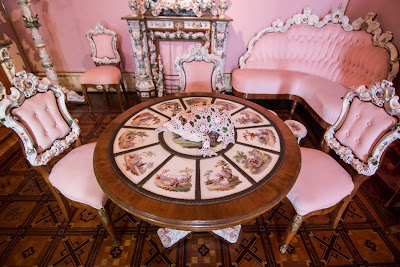REVIEWED: Joana Vasconcelos at the Ajuda National Palace
By Sandra Camacho
+2001-2005.jpg) |
Joana Vasconcelos, The Bride, 2001-2005
Courtesy of the artist.
|
Following her hugely successful
retrospective attracting 1.6 million visitors at the Palace of Versailles last
summer, Paris-born Portuguese artist Joana Vasconcelos (b.1971) is now
exhibiting in another grand environment - the Ajuda National Palace, Lisbon.
The exhibition follows the same curatorial concept as at Versailles - giving a
broad view of the artist’s career but this time including The Bride (2001-2005), a chandelier piece composed of virginally
white tampons deemed inappropriate to show at Versailles.
 |
Joana Vasconcelos, Petit Gâteau, 2011
Courtesy of the artist.
|
Joana Vasconcelos can be contentious,
particularly in Portugal where the work of local contemporary artists is mainly
reflective, quiet and experimental, none of which at first glance describes Vasconcelos’s
own work. The first piece at the Ajuda National Palace, Petit Gâteau (2011), a giant cupcake made out of colourful plastic
moulds shaped like pretzels, pears or apples is confounding in its placement partly
because the viewer is initially not fully prepared to see contemporary works in
a neo-classical setting but mostly because, of all the works, the piece may
seem out of place in a palace. It is only after encountering the second piece
in the darkened main foyer, The Garden of
Eden (Maria Pia) (2007-2013), a fantastical installation of reflective
flowers popular in the 1980s that the experiment of exhibiting contemporary art
in a palace begins to appeal and make sense.
 |
Joana Vasconcelos, The Garden of Eden (Maria Pia), 2007-2013
Courtesy of the artist.
|
The Ajuda National Palace, built between
1796 and the late 1800s, served as a residence for the Portuguese monarchy
until the establishment of the Republic in 1910. Presently not in its full
splendour, the silk lining the walls is falling apart and the stonework shows
signs of ageing. The palace is visited almost entirely by tourists - something
the present exhibition seeks to change.
 |
Joana Vasconcelos, Carmen, 2012
Courtesy of the artist.
|
Vasconcelos is known for constructing pieces
around populist Portuguese iconography and adapted everyday objects and consequently
viewers may find it strange to encounter her works in a royal palace that was
once inaccessible to the general population. However, the exhibition works. If one
sees the artist’s sculptures in a white gallery setting, they stand out for
being big, loud and garish. At the Ajuda National Palace, as I am sure it
was at Versailles, they shine through. Their garishness fades into a background
of extreme luxury and excess which ironically enables the viewer to focus on
the works’ content.
 |
Joana Vasconcelos, Alorna, 2013
Courtesy of the artist.
|
Take her use of Rafael Bordalo Pinheiro’s
ceramics; there are few things that represent Portuguese popular culture as
well as the works of the 19th century ceramicist/cartoonist. Bordalo Pinheiro’s
works embody the discontent of the general populace with the ruling elites. These
included the former royal family whose old property is now hosting larger-than-life
sculptures of crabs, frogs or hunting dogs covered in white doilies that echo popular
home décor of the mid 20th century. Strangely enough, Bordalo Pinheiro’s rough ceramics
do not seem out of place in the royal collection of Meissen porcelain, but
instead enable the viewer to establish a connection between regal decorative
tastes of centuries past with those of one’s own grandmothers. In this original
manner, Vasconcelos injects a sense of humanity into royalty itself.
 |
Joana Vasconcelos, Maria Pia, 2013
Courtesy of the artist.
|
It is this capacity that makes the
exhibition a success. It displays both the work of Vasconcelos and the setting
of the Ajuda National Palace in a new and favourable light. In the midst of
all the grandeur, Vasconcelos’s pieces no longer appear tacky - as some in Portugal
describe her work - and the palace itself appears fresh, fun and accessible.
The late royals would have most likely been unimpressed at being associated with
such a joyful and open endeavour but it is precisely this, together with
Vasconcelos’s pieces that are attracting visitors to the palace, particularly
locals.
Note: Joana Vasconcelos will be representing Portugal in this year’s Venice Biennale.
Note: Joana Vasconcelos will be representing Portugal in this year’s Venice Biennale.
 |
Joana Vasconcelos, Full Steam Ahead (Red #1), 2012
Courtesy of the artist.
|
 |
Joana Vasconcels, Marilyn (AP), 2011
Courtesy of the artist.
|
 |
Joana Vasconcelos,
Coração Independente Vermelho (Red Independent
Heart), 2005
Courtesy of the artist.
|
JOANA VASCONCELOS AT THE AJUDA NATIONAL PALACE, Lisbon, Portugal, 23 Mar - 25 Aug 2013
